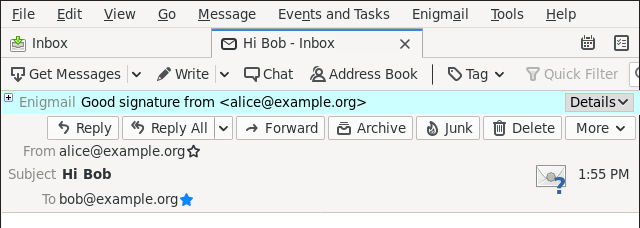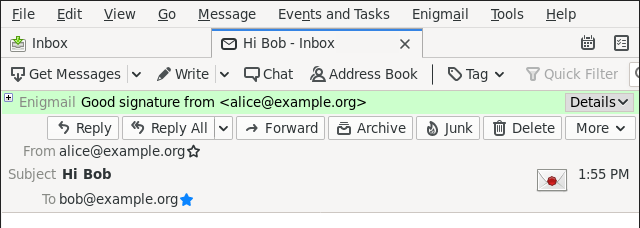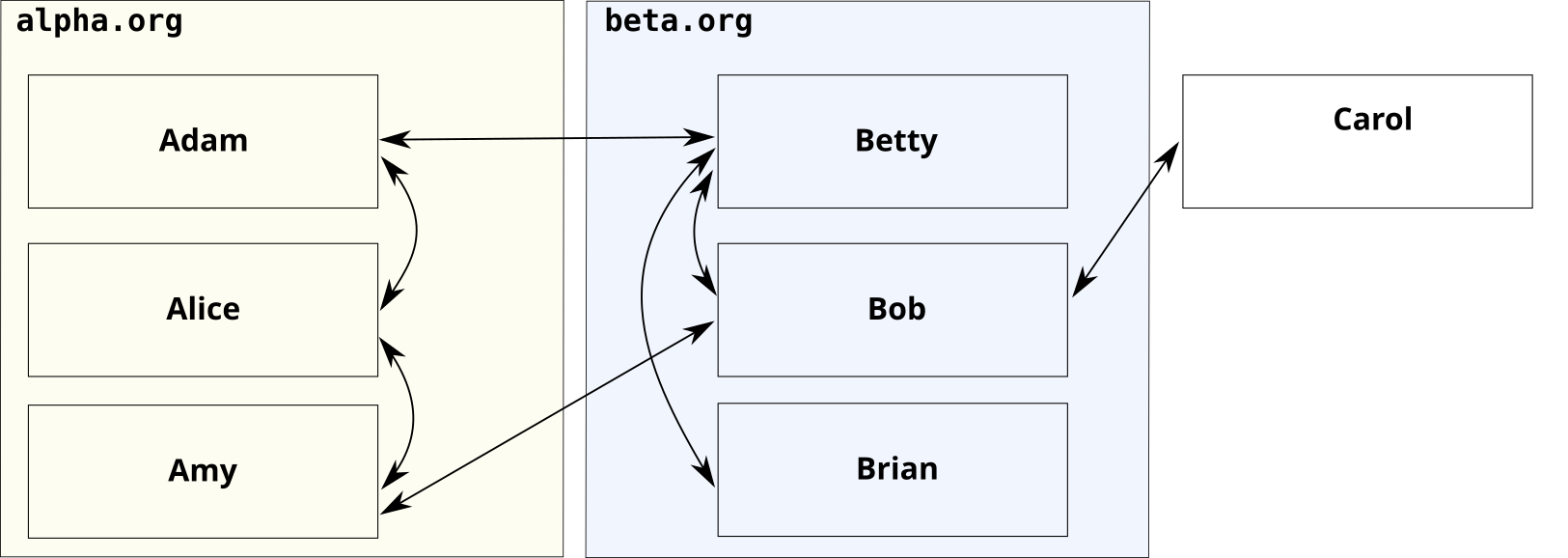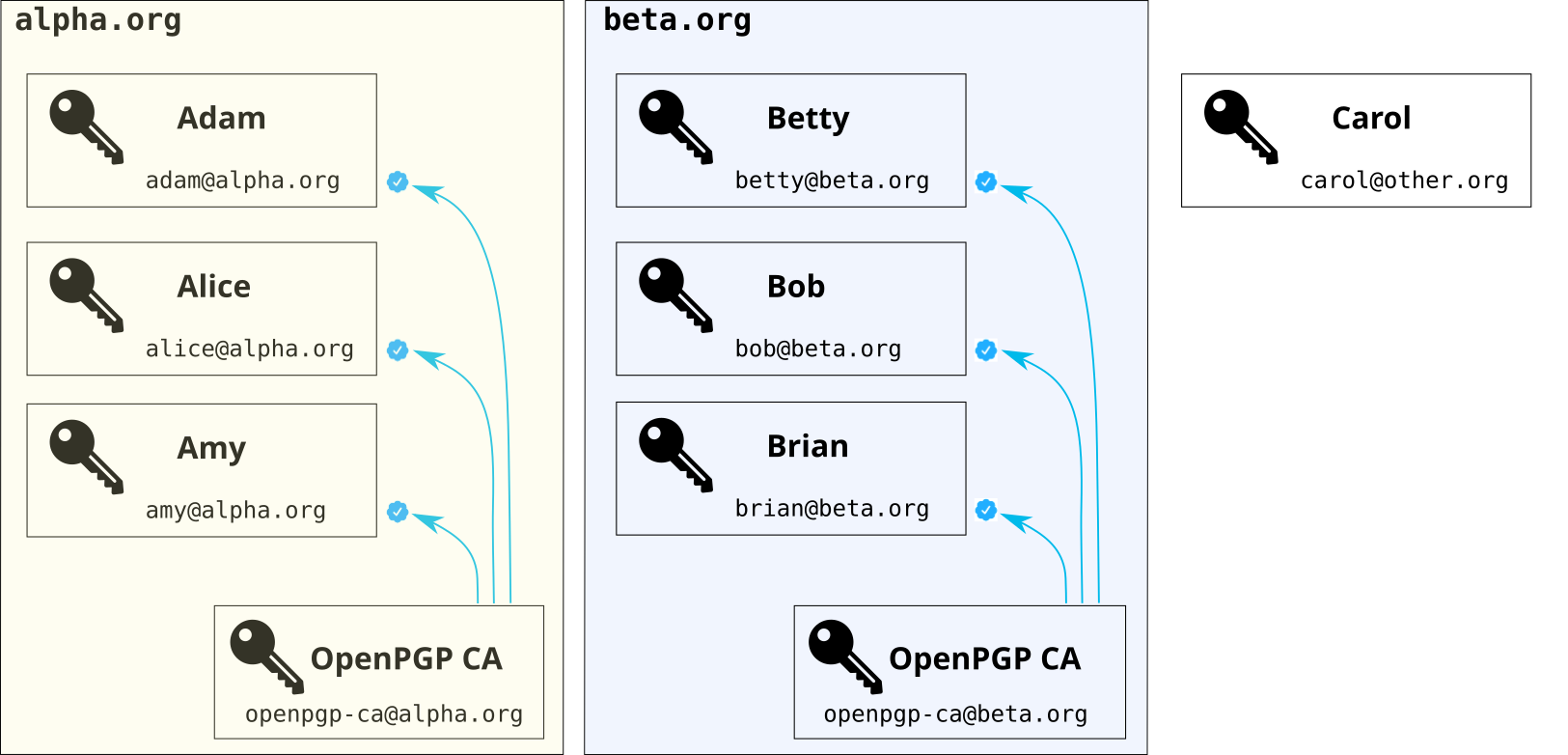OpenPGP CA: a high-level overview
OpenPGP CA has two aspects. It is both:
-
A paradigm (a set of best practices) for the use of OpenPGP in organizations or groups.
-
Concrete tooling that helps apply this paradigm in practice.
This text focuses on the first aspect. We discuss the approach that OpenPGP CA proposes, independent of concrete software tools1.
Concepts
The OpenPGP CA paradigm touches on a number of concepts:
- OpenPGP
- Authentication
- Key discovery
- User key revocation
We’ll briefly introduce them, next:
OpenPGP
OpenPGP is an established standard for encryption and digital signing. It is often used with email2.
There are many implementations of OpenPGP. All of them interoperate based on a shared standard.
One very well known implementation is GnuPG. Thunderbird directly supports OpenPGP using the RNP implementation3. Other implementations include OpenPGP.js and Sequoia PGP (OpenPGP CA uses Sequoia PGP internally).
OpenPGP CA works seamlessly with existing OpenPGP software.
Authentication
One of the most important aspects of secure communication is making sure that your messages go to the right person and that messages you receive actually came from the person they claim to. This is authentication.
For many use cases, it’s indispensable to establish authentication before using encryption. Using encryption on an unauthenticated communication channel is risky - we can’t tell if our communication is secure.
Authentication is the core of what OpenPGP CA deals with. The OpenPGP CA paradigm greatly simplifies authentication for users and makes it commonplace.
Key discovery
To start secure communication with a new person, you need to have a copy of their public key. The process4 of finding that key is called “key discovery”.
OpenPGP CA facilitates key discovery, by making it easy for the admin to publish keys in places that OpenPGP software normally looks for them (e.g. WKD and key servers). And, it makes it easier to keep those directories up to date.
Revocation of user keys
Finally, OpenPGP CA simplifies managing keys by (optionally) storing revocation certificates for your users, and making it easy to publish a revocation, if and when that is necessary.5
The need for OpenPGP CA, or: how OpenPGP gets introduced to organizations
Anecdotal evidence suggests that OpenPGP is often introduced to an organization by a technically competent person who recognizes a need for secure communication. That person then convinces everyone to adopt OpenPGP. They organize a briefing (which is sometimes called a CryptoParty), and teach everyone how to generate a key, how to do key discovery, how to certify keys, etc. When done well, the members of the organization learn what they need to do to communicate securely.
But, even in the best cases, most users often only have a superficial understanding of what they need to do, and the technical leader needs to provide them with intense support. And, due to the high overhead, authentication is often neglected based on the perception that “usually we will find the correct key in some kind of ad-hoc manner, anyway.”
OpenPGP CA and authentication
The overarching goal of OpenPGP CA is that users can be certain they are using the correct OpenPGP keys for their communication partners. This is called authentication: making sure that a key is indeed the correct key for the other party.
Imagine that we’re receiving an email from Alice. Our email software can indicate to us whether we can authenticate Alice’s OpenPGP key.
For example, the Enigmail plug-in for Thunderbird 68 shows the authentication status for a signed email with two visual cues:
- the color of the bar at the top of the email window, and
- the envelope icon on the right side of the window.
This is how an email looks from an unauthenticated sender:

In contrast, when authentication works, Thunderbird/Enigmail shows this with a green bar, and a wax seal on the envelope icon, both indicating that we have an authenticated key for Alice:

More precisely, what is authenticated is the association between an identity and a key. Authentication deals with identities and asserts that there is reason to believe that a key in question is indeed controlled by a certain identity.
If we want to be sure that an identity associated with a key is correct, we need to perform steps to authenticate that key. A traditional method to authenticate a key with OpenPGP is to have the owner (here: Alice) communicate the fingerprint of that key. We might get it in person - asking the owner to confirm that the fingerprint we have is the correct one. Or, the person might have given us a business card that includes their fingerprint. These approaches are time-consuming, and often not possible (what if you never meet the person in real life?). OpenPGP CA simplifies authentication by non-exclusively delegating that task to a trusted party.
The importance of authentication
When we obtain an OpenPGP key that claims to belong to Alice from an untrusted source, we cannot be sure if the key is indeed controlled by Alice, and not by some malicious party.
This is a problem, because a malicious party could perform various types of attacks, including:
-
send us a seemingly correctly signed email (which might lead to false confidence in the origin of a piece of email - such attacks are called phishing or spear-phishing), or
-
intercepting our attempts to securely communicate with Alice through an encrypted channel (“man-in-the-middle attack”).
Records of authentication
OpenPGP CA introduces tooling that an admin can use to record organizational knowledge in a form that OpenPGP software understands6.
Such a record makes a connection between an identity and a public key:
- Alice Adams’ email address is
alice@example.org(an identity) - “This is a copy of Alice’s OpenPGP public key”.
Giving users automatic authentication with OpenPGP CA
We can classify communication partners into three categories:
- people in the same organization,
- people in an affiliated organization, and
- others.
We consider two organizations to be affiliated if they often communicate with each other. OpenPGP CA is designed to secure the first two types of communication, but it can even help with the third type.
The following figure shows two affiliated organizations, alpha.org
and beta.org, a few of their members, a third-party (Carol). The arrows show
who communicates with whom. This communication pattern is typical for many
organizations.

Using OpenPGP CA, the admin of alpha.org and the admin of beta.org can
ensure that all of their users’ OpenPGP-based tools can automatically
authenticate their main communication partners.
To do this, the CA admins authenticate user keys in their organizations
and distribute the information that they have done so.
The blue icons represent records of the CA admins’ verification:

Now, after the initial setup7, normal users don’t manually authenticate (most of) their communication partners. The admins do that work for them, with the help of OpenPGP CA.
Intended Audience
OpenPGP CA helps organizations or groups model trust relations in OpenPGP.
We use the term “organization” to refer to any group of people who might use OpenPGP CA together - whether they are an informal group, a commercial organization, or any other form - such as:
- Journalistic organizations
- Human rights groups
- Informal groups of activists
- A company or a department at a company
OpenPGP CA’s approach is based on the observation that in organizations, users already trust their administrators with access to their data (including email) and the integrity of their systems. So, asking the administrator to also maintain a directory of users and keys does not require placing additional trust in them.
Users need to learn fewer skills
Implementing any new security practice requires educating users about its operational aspects. The difficulty is making sure users are not overwhelmed, as that undermines the security goals.
Traditionally, users of OpenPGP have had to learn many technical details. These details are necessary to achieve the security goals. OpenPGP CA doesn’t remove these details, but shifts them to a new actor, the OpenPGP CA admin. This greatly lessens the burden placed on normal users, who are more interested in getting their job done than understanding technical details.
Concretely, OpenPGP CA users only need to be taught a few high-level skills to get significant value from OpenPGP:
- encrypt and sign email, as well as
- how to recognize encrypted and signed email.
OpenPGP CA alleviates non-technical users from having to learn many low-level tasks, such as:
- doing key discovery,
- checking that a key belongs to the intended party (authentication and certification), and
- creating their own key.
This allows users to focus on the indispensable high-level concerns and reduces the risk of user errors.
This setup has several advantages for users. By delegating authentication to an in-house CA, the cognitive burden placed on users is significantly reduced: users don’t have to compare fingerprints or even understand keys or certifications to effectively use OpenPGP. At the same time, because OpenPGP CA uses OpenPGP’s existing mechanisms, users with special needs are free to use other approaches in their OpenPGP environments, e.g., directly verifying someone’s key in the customary manner.
The OpenPGP CA admin role
What is the CA admin role?
OpenPGP has traditionally been aimed at individual users, each fending for themselves. Our approach introduces the role of an “OpenPGP CA admin”, a per-organization role that serves as a centralized facilitator for OpenPGP users in that organization.
The OpenPGP CA admin authenticates users within an organization, so that users within that organization are mutually authenticated. Users can use each others’ OpenPGP keys with confidence - without the need to spend effort on low-level details about key discovery and authentication.
The key assumption for OpenPGP CA is that users have a common trusted party who can perform this OpenPGP CA admin role for them.
In formal organizations, this might be the existing OPSEC team. In an informal group it might be a person who volunteers for that job and is viewed by the other team members as both technically competent and trustworthy.
Trade-offs of centralizing responsibility for authentication
Users need to trust their OpenPGP CA admin to do OpenPGP authentication on their behalf. This effectively centralizes authentication, which deviates from OpenPGP’s decentralized tradition. However, contrary to TLS where a third party customarily does the authentication, users in an organization already trust their administrator.
In many cases, the OpenPGP CA admin role will be filled by the users’ system administrator. In that role, the administrator already controls the users' systems - and can install arbitrary software, for instance.
In other words, such an administrator is already in a position where they could undermine the integrity of users’ systems in practically limitless ways.
Therefore trusting this admin to also authenticate business relationships does not change existing trust boundaries - and does not increase the organization’s risk.
In short, the centralization that the OpenPGP CA admin role brings is not a significant change to users’ threat models, and does not undermine OpenPGP’s decentralized nature.
Risks when a CA admin makes mistakes
The role of the CA admin centralizes tasks that would otherwise be the responsibility of individual users. As described above, this brings a lot of benefits for users, however, it also introduces new, centralized risks.
One particular difficulty in deploying OpenPGP CA is that the CA’s key needs to be well protected. If it is compromised, then an attacker is able to mark arbitrary keys as authenticated.
Apart from that, when authenticating keys, the CA admin needs to be diligent. The CA admin needs to have a good understanding of OpenPGP concepts to be able to perform their tasks correctly. If the CA admin makes mistakes, users are at risk. Depending on the consequences, not using OpenPGP CA may be better than creating a false sense of security.
Comparing the OpenPGP CA admin role with CAs for TLS server certificates
The concept of a certificate authority (CA) is well known in the context of TLS server certificates, which are used for authenticated and encrypted communication on the web.
TLS certificates claim an identity (the domain name of a website). This identity is verified and cryptographically vouched for by a CA. CAs for TLS server certificates act as a group of globally trusted verifiers of identity (often, but not always, for-profit). To organizations that use TLS certificates, these CAs are external actors.
While TLS server certificates of course bring massive benefits for secure communication on the web, there are also problems:
- The interests of CAs in the TLS space are not aligned with the interests of their users.
- For-profit CAs are driven by profit, not by the needs of users.
- Law enforcement might interact with these CAs in ways that are contrary (and opaque) to the users of the certificates and detrimental to their goals. CAs agree to help, because they don’t want to cause trouble with law enforcement.
These risks are real. TLS CAs have been known to be sloppy and potentially malicious. And, the authentication that the CAs perform is often extremely weak.
Our main observation about TLS in this context is that it centralizes trust in untrustworthy third parties.
Interests of the OpenPGP CA admin and their users are aligned
In contrast, OpenPGP CA facilitates a decentralized (and optionally federated) approach to trust and authentication. OpenPGP CA embraces OpenPGP’s decentralized trust model and makes it easy to leverage its inherent benefits.
Trust management with OpenPGP CA is somewhat centralized - but only within the scope of individual organizations. The interests of the in-house CA admin are strongly aligned with the interests of the users and the organization overall.
Using OpenPGP CA does not require placing trust in an outside third party with potentially conflicting interests. This is essential for activists, journalists, and lawyers.
Federation: Bridges between organizations
OpenPGP CA cannot only be used to create authenticated paths between users in a single organization, but also between organizations, in a decentralized, federated manner.

Affiliated organizations that use OpenPGP CA can easily set up what we call a bridge between their respective CAs. Creating a bridge creates authenticated paths between all users in the two organizations - users in each organization can authenticate keys of users in the other without any additional effort.
This makes sense when the CA admins believe that the other organization’s CA admin does a good job authenticating their user’s keys in OpenPGP CA.
Again, we want to take advantage of existing trust boundaries. When an organization creates a bridge to another organization, the latter organization’s CA admin is only trusted to authenticate users in their own organization. This is done by scoping the trust: when the CA admin from organization A authenticates the CA admin from organization B, they indicate that B should only be trusted to authenticate users in the same organization. This is done using existing OpenPGP mechanisms. Specifically, by matching on the email’s domain name.
No key escrow
Centrally storing users’ private key material has legitimate uses - however, it also comes with massive risks.
OpenPGP CA does not do key escrow - that is, even when OpenPGP CA generates keys for users, the private key material is never stored in the OpenPGP CA database.
Complements existing OpenPGP usage
Because OpenPGP CA works within the existing OpenPGP framework, i.e., it doesn’t require any modification of existing OpenPGP software, users do not need any new software to take advantage of OpenPGP CA. Concretely, they can continue to use existing email clients and encryption plugins. Further, OpenPGP CA can co-exist with other authentication approaches like traditional key certification workflows.
OpenPGP CA can be rolled out gradually within an organization.
While OpenPGP CA prescribes some aspects of how OpenPGP keys and certifications should be handled, our approach offers some degrees of freedom, so that security specialists in organizations can tailor their use to their specific needs. That said, our framework/paradigm makes OpenPGP key management less ad-hoc and more systematic.
OpenPGP CA as tooling for the admin
OpenPGP CA vastly improves the capabilities of the administrator by giving them tooling to model existing trust relationships in their organization.
Traditionally, tooling in the OpenPGP ecosystem was mainly aimed at users. Dedicated administrators of OpenPGP setups have built ad-hoc tools for tasks they perform, but these were point solutions, and often incomplete.
The benefits of OpenPGP CA are - at least in theory - not particular to OpenPGP CA: a dedicated administrator could perform all the relevant tasks manually. However, in practice, these tasks are so hard for administrators to perform correctly with existing tooling that only very dedicated organizations use this type of setup.
Is OpenPGP CA suitable for my use case?
OpenPGP CA is not for everyone. Here are some considerations:
- OpenPGP CA is for groups. An individual will not profit from installing OpenPGP CA, because they have no one to delegate authentication to.
- There has to be a trusted, competent party who can perform the OpenPGP CA
admin role.
The CA admin needs to have the relevant knowledge and skill set. Users must trust the admin to do authentication on their behalf. - OpenPGP CA exposes the structure of the organization. For most companies, this is not a problem, because they already have employee directories. For some activist groups, this may be a problem.
-
The OpenPGP CA project provides a set of tools. However, our central interest is to see more use of authentication in the larger OpenPGP space, independent of the concrete software that is used.
So we are very excited that Proton Mail launched an implementation of the OpenPGP CA paradigm for their email service in October 2022. ↩︎
-
The other widely used email encryption standard, which OpenPGP CA does not deal with, is S/MIME. ↩︎
-
Direct OpenPGP support in Thunderbird, based on RNP, was introduced in version 78. Before that, the Enigmail plugin provided OpenPGP support for Thunderbird. ↩︎
-
Key discovery can be a manual or an automated process. Automated key discovery is more convenient for users. ↩︎
-
This style of “revocation escrow” can be useful when a user loses access to their private key material. It is often in the user’s and the organization’s best interest to revoke that key, then (the revocation signals to third parties that they should not use that key anymore).
Centrally managing revocations is of course not appropriate in all contexts. ↩︎
-
In technical terms, OpenPGP CA creates “third party certifications”. Those are often referred to colloquially as “signatures”, in the OpenPGP context.
Third party certifications are machine-readable statements (they are, in turn, also cryptographically secured: the issuer - in our case, a CA - commits to the certification by signing it with their private key). The OpenPGP standard defines these certifications, all compliant implementations understand them. ↩︎
-
We’re glossing over the details of how that “initial setup” looks, here. See the section on bridging, further down, for one possible approach.
Putting aside details: each organizations’ admins can set up user OpenPGP environments to rely on the appropriate CA(s). Or give concrete guidance how users should configure their systems. ↩︎
